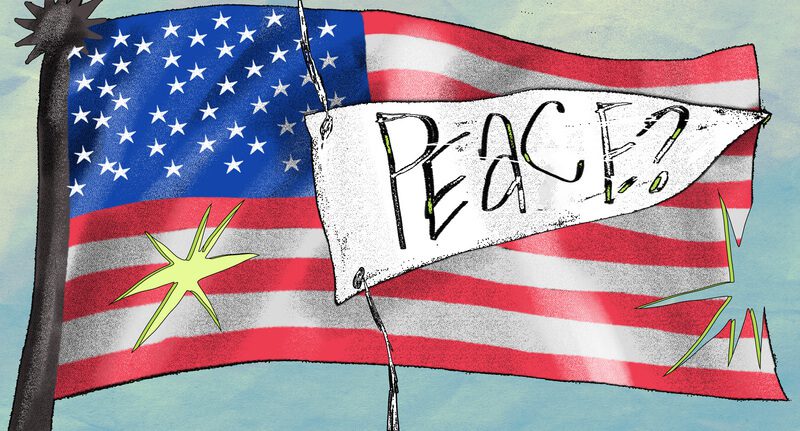Ukraine Has No Plan B: What Will Happen to Western Support and Whether Kyiv Will Cope without Help

Ukraine continues to rely on financial and military support from the West and has no alternative plan in case it stops. At least that’s what Foreign Minister Dmytro Kuleba says. But this is a rather risky position, given the problems with the allocation of multibillion-dollar aid packages from the United States and the EU. And Western media point out that due to the possible threat of reducing or stopping further assistance to Kyiv, Washington plans to change the strategy of Ukraine’s war against Russia and abandon plans to completely defeat the Russian army to start peace talks.
What will happen with further assistance from the United States and the European Union, what alternatives Ukraine has, and what war strategy could be chosen in Washington, Zaborona editor Svitlana Hudkova discussed with experts.
The United States has run out of money
On December 27, 2023, US President Joe Biden signed a $250 million aid package for Kyiv, which may be the last. “We have already provided Ukraine with the last security assistance package for which we have funds, just before the New Year and after Christmas. Not everything that was signed on the 27th has been delivered to Ukraine. This will happen in the coming days and weeks. Further, there is no funding,” said John Kirby, coordinator of the US National Security Council, at a briefing on January 3.
Further support for Ukraine will depend on the decision of Congress, which has been unable to agree on a $61 billion military aid bill for Ukraine since the fall of 2023. The document is being blocked by Republicans who demand that the bill include funding to strengthen border and migration measures on the US-Mexico border. On January 8, it became known that representatives of the Democratic and Republican parties in the US Congress had reached an agreement on the government’s budget for the 2024 fiscal year, which began on October 1.

Another attempt to vote is to take place in January, but there is no absolute certainty that the aid will be approved, political analyst Volodymyr Fesenko told Zaborona.
“What is happening in Congress is unprecedented in recent years. Against the backdrop of a rather acute and conflictual election campaign, the actions of Congress are irrational. And this creates problems for the United States itself, not to mention Ukraine. The United States is on the verge of a shutdown again, although this has happened before, but not so often,” the political scientist says.
Given these risks, Fesenko believes that congressmen will be able to overcome their differences, including those over strengthening the border with Mexico, to vote on the annual budget together with aid to Ukraine. But there is a risk that this will not happen. In this case, the US administration has mechanisms to continue support, but it will be much less assistance.
“Theoretically, there are options when, within the framework of the president’s powers, arms sales for a specific country can be made without the consent of Congress. This is currently working for Israel and may work for Ukraine. But this is not a permanent support. Therefore, I think the White House will look for options to continue support on a regular basis. In my opinion, the White House made a huge mistake by not extending the lend-lease. This could have been an option to support Ukraine in the current situation,” Fesenko said.
The situation is better with the allocation of 50 billion euros by the EU to Ukraine for four years. So far, the aid has been blocked after Hungary vetoed it. But unlike the United States, the EU has the legal ability to override, if not overcome, Prime Minister Viktor Orban’s veto.
“The most likely scenario is that the EU will at least partially unblock the funds for Hungary, so Orban will agree to allocate funding for Ukraine. If the blockade continues, there are already two fallback scenarios. The first is that there will be no direct budgetary funding, and the money will be issued under EU guarantees. Second, the assistance will be provided through individual EU countries,” the expert explained.

Illustration: Kateryna Kruhlyk / Zaborona
Ukraine has no plan B
Despite the current difficulties with financing, Ukraine believes in continuing support from the West and has no alternative plan in case it stops. “We don’t have a plan B. We are confident in plan A,” Ukrainian Foreign Minister Dmytro Kuleba told CNN.
The foreign minister is confident that the EU and the US will continue to help Ukraine, as it is an investment in the defense of NATO and the prosperity of the American people. He noted that the price for other countries will be much higher in the future if they stop supporting Ukraine now and allow Russia to win.
However, political analysts are confident that the government has a plan B, and Kuleba’s statement is just a diplomatic game.

One option, according to political scientist Taras Zahorodnyi, is to develop our own military-industrial complex and strengthen our economy.
“We have long been required to develop our own military-industrial complex and economy, especially since we have such resources inside the country. The more weapons we have, the less hesitation our Western partners will have in providing us with military assistance. They invest in the strong, not in the victims. If we don’t invest in our victory, why should American or European taxpayers?” says the political scientist.
Volodymyr Fesenko agrees with him, noting that an increase in military production in Ukraine or neighboring countries will allow us to be less dependent on Western aid. But this requires money. Zahorodniy offers a solution to this problem. “In 2022, the National Bank printed and added 400 billion hryvnias into the Ukrainian economy. As we can see, this did not create any threat, so there is no need to say that it is impossible. Moreover, the IMF allows for such a possibility under certain circumstances. Therefore, it is possible to do this and not depend on aid,” explains the political scientist.
But this is a temporary solution, as are agreements with international financial institutions and individual countries on additional financial and military aid packages.
“We have agreed on tranches from the IMF and the World Bank worth more than $2 billion. There are agreements with individual countries on additional financial and military aid packages. But this works for the next few months, and more systemic funding is needed in the future. Otherwise, we will have to think about plan B, namely, cutting budget expenditures, which is already being worked out. Therefore, it is important for us that funding from the USA and the EU continues,” Fesenko adds.

Illustration: Kateryna Kruhlyk / Zaborona
Washington is changing Ukraine’s strategy in the war with Russia
The White House, according to Politico, is seeking to change Ukraine’s strategy because of the possible threat of reducing or stopping further aid to Kyiv from the US and EU. In particular, it was noted that Biden allegedly wants to tacitly shift the emphasis from supporting Kyiv’s goals of completely defeating Russia to improving Ukraine’s position in possible negotiations with Russia to end the war. US State Department spokesman Matthew Miller denied this information.
According to Fesenko, the information in this article could not be true, because the United States has never had a strategy to completely defeat Russia. “The strategy of the United States was to contain Russia and not allow it to win this war. This was and is the strategy. If Washington had been aimed at defeating Russia, Ukraine would have received long-range missiles, aircraft, and more long ago. We received air defense systems only a year after the Russian invasion,” he says.
According to the political analyst, Washington’s strategy in 2023 focused on facilitating the Ukrainian offensive so that the Defense Forces could reach the Azov Sea coast and the administrative border with Crimea. After that, negotiations with Russia on ending the hostilities were to begin. But even here, there was no talk of negotiations after the complete liberation of the occupied territories. At the moment, discussions with foreign partners have begun to determine a joint military strategy for 2024.
“A joint strategy is being developed for the next six months, given the current funding problems. The first task is to defend and deplete Russian troops actively. And then depending on the situation. If possible, we will resume offensive actions. But, most likely, in 2024, the strategy of forcing Russia to start peace talks through the destruction of its military potential will dominate. That is why there will be a supply of F-16s and, I think, long-range missiles and other high-quality weapons,” Fesenko said.
At the same time, Taras Zahorodnyi believes that Washington may indeed have a plan outlined in the Politico article, but there is no need to worry about it.
“The Pentagon has different response scenarios for any event. They calculate everything. So, do they have a folder with a similar scenario? It is quite possible. Can Ukraine change it? Yes, we can. When we stamp missiles out and hit Russian positions at the front and military facilities in Russia, the scenario will be different. If we are tough, then this folder will not be used, but another one will be used: we will finish off Russia,” the expert noted.






